A Comprehensive Study of Assessing Sustainable Agricultural Water Management under Changing Climate Scenarios—A Regional Basis Study in the Western Ghats, India
Abstract
:1. Introduction
2. Materials and Methods
2.1. Study Area and Inputs
2.2. LULC Projection
2.3. VIC Model Description
- (1)
- Baseline: The period 1981–2010 has been taken as the base period for meteorological data of wind, precipitation, and Tmin and the year 2016 has been taken as the base period for LULC data.
- (2)
- Future Scenario 1: CMIP6 meteorological variable (2020–2050) and LULC data during 2030.
2.4. Estimation of Monthly Water Availability
2.5. Estimation of Monthly Crop Water Requirement
3. Results
3.1. Performance of GCM Data
3.2. Calibration and Validation of VIC Model
3.3. LULC Change
3.4. Impact of Combined Change on Water Balance Components
3.4.1. Rainfall
3.4.2. Surface Runoff
3.4.3. Evapotranspiration (ET)
3.4.4. Regional Impacts
3.5. Comparison of Future Irrigation Demand
4. Discussion
5. Conclusions
- The MPILR GCM of the CMIP6 model performs better in capturing the annual mean rainfall and gives reliable projections of future rainfall change for all three regions of the WG region compared to other GCMs.
- The future projected LULC map for 2030 shows an increase in built-up areas (+1.27%) and wasteland reducing to 2.1% (−1.47%). Also, the land class that requires irrigation was reduced by 1.16%.
- For the future under the SSP 4.5 scenario, there is an overall increase in rainfall observed in the lower region of the basin. This projection aligns with recent flooding events that occurred in the lower regions of Kerala.
- The study indicates increasing IWD (~8 mm/day), particularly in the months of March, April, and May, in different parts of the WG region from historical to future periods. The IWD values show a decreasing trend in most of the upper and middle regions of the basin but an increasing trend in the lower region.
Author Contributions
Funding
Institutional Review Board Statement
Informed Consent Statement
Data Availability Statement
Acknowledgments
Conflicts of Interest
References
- Saranya, P.; Krishnakumar, A.; Kumar, S.; Krishnan, K.A. Isotopic study on the effect of reservoirs and drought on water cycle dynamics in the tropical Periyar basin draining the slopes of Western Ghats. J. Hydrol. 2020, 581, 124421. [Google Scholar] [CrossRef]
- Di Baldassarre, G.; Wanders, N.; AghaKouchak, A.; Kuil, L.; Rangecroft, S.; Veldkamp, T.I.E.; Garcia, M.; van Oel, P.R.; Breinl, K.; Van Loon, A.F. Water shortages worsened by reservoir effects. Nat. Sustain. 2018, 1, 617–622. [Google Scholar] [CrossRef]
- DeFries, R.; Liang, S.; Chhatre, A.; Davis, K.F.; Ghosh, S.; Rao, N.D.; Singh, D. Climate resilience of dry season cereals in India. Sci. Rep. 2023, 13, 9960. [Google Scholar] [CrossRef]
- Suzuki, R.; Xu, J.; Motoya, K. Global analyses of satellite-derived vegetation index related to climatological wetness and warmth. Int. J. Climatol. A J. R. Meteorol. Soc. 2006, 26, 425–438. [Google Scholar] [CrossRef]
- Chanapathi, T.; Thatikonda, S. Investigating the impact of climate and land-use land cover changes on hydrological predictions over the Krishna river basin under present and future scenarios. Sci. Total Environ. 2020, 721, 137736. [Google Scholar] [CrossRef]
- Sharannya, T.M.; Mudbhatkal, A.; Mahesha, A. Assessing climate change impacts on river hydrology–A case study in the Western Ghats of India. J. Earth Syst. Sci. 2018, 127, 1–11. [Google Scholar] [CrossRef]
- Sharannya, T.M.; Venkatesh, K.; Mudbhatkal, A.; Dineshkumar, M.; Mahesha, A. Effects of land use and climate change on water scarcity in rivers of the Western Ghats of India. Environ. Monit. Assess. 2021, 193, 820. [Google Scholar] [CrossRef]
- Sadhwani, K.; Eldho, T.I.; Karmakar, S. Investigating the influence of future landuse and climate change on hydrological regime of a humid tropical river basin. Environ. Earth Sci. 2023, 82, 210. [Google Scholar] [CrossRef]
- Hao, L.; Sun, G.; Liu, Y.; Wan, J.; Qin, M.; Qian, H.; Liu, C.; Zheng, J.; John, R.; Fan, P.; et al. Urbanization dramatically altered the water balances of a paddy field-dominated basin in southern China. Hydrol. Earth Syst. Sci. 2015, 19, 3319–3331. [Google Scholar] [CrossRef]
- Anand, J.; Gosain, A.K.; Khosa, R. Prediction of land use changes based on Land Change Modeler and attribution of changes in the water balance of Ganga basin to land use change using the SWAT model. Sci. Total Environ. 2018, 644, 503–519. [Google Scholar] [CrossRef] [PubMed]
- Dwarakish, G.S.; Ganasri, B.P. Impact of land use change on hydrological systems: A review of current modeling approaches. Cogent Geosci. 2015, 1, 1115691. [Google Scholar] [CrossRef]
- Oswald, C.J.; Kelleher, C.; Ledford, S.H.; Hopkins, K.G.; Sytsma, A.; Tetzlaff, D.; Toran, L.; Voter, C. Integrating urban water fluxes and moving beyond impervious surface cover: A review. J. Hydrol. 2023, 618, 129188. [Google Scholar] [CrossRef]
- Sadhwani, K.; Eldho, T.I.; Jha, M.K.; Karmakar, S. Effects of Dynamic Land Use/Land Cover Change on Flow and Sediment Yield in a Monsoon-Dominated Tropical Watershed. Water 2022, 14, 3666. [Google Scholar] [CrossRef]
- Schilling, K.E.; Jha, M.K.; Zhang, Y.-K.; Gassman, P.W.; Wolter, C.F. Impact of land use and land cover change on the water balance of a large agricultural watershed: Historical effects and future directions. Water Resour. Res. 2008, 45, 6644. [Google Scholar] [CrossRef]
- Wheater, H.; Evans, E. Land use, water management and future flood risk. Land Use Policy 2009, 26 (Suppl. 1), S251–S264. [Google Scholar] [CrossRef]
- Reddy, C.S.; Jha, C.S.; Dadhwal, V.K. Assessment and monitoring of long-term forest cover changes (1920–2013) in Western Ghats biodiversity hotspot. J. Earth Syst. Sci. 2016, 125, 103–114. [Google Scholar] [CrossRef]
- Davidar, P.; Arjunan, M.; Mammen, P.C.; Garrigues, J.P.; Puyravaud, J.P.; Roessingh, K. Forest degradation in the Western Ghats biodiversity hotspot: Resource collection, livelihood concerns and sustainability. Curr. Sci. 2007, 93, 1573–1578. [Google Scholar]
- Ramesh, B.R.; Venugopal, P.D.; Pélissier, R.; Patil, S.V.; Swaminath, M.H.; Couteron, P. Mesoscale patterns in the floristic composition of forests in the central Western Ghats of Karnataka, India. Biotropica 2010, 42, 435–443. [Google Scholar] [CrossRef]
- Kumar, S.N.; Aggarwal, P.K.; Rani, S.; Jain, S.; Saxena, R.; Chauhan, N. Impact of climate change on crop productivity in Western Ghats, coastal and northeastern regions of India. Curr. Sci. 2011, 101, 332–341. [Google Scholar]
- Kalkhan, M.A.; Reich, R.M.; Czaplewski, R.L. Variance estimates and confidence intervals for the Kappa measure of classification accuracy. Can. J. Remote Sens. 1997, 23, 210–216. [Google Scholar] [CrossRef]
- Lu, D.; Weng, Q. A survey of image classification methods and techniques for improving classification performance. Int. J. Remote Sens 2007, 28, 823–870. [Google Scholar] [CrossRef]
- Adhikari, S.; Southworth, J. Simulating forest cover changes of bannerghatta national park based on a CA-Markov model: A remote sensing approach. Remote Sens. 2012, 4, 3215–3243. [Google Scholar] [CrossRef]
- Liping, C.; Yujun, S.; Saeed, S. Monitoring and predicting land use and land cover changes using remote sensing and GIS techniques—A case study of a hilly area, Jiangle, China. PLoS ONE 2018, 13, e0200493. [Google Scholar] [CrossRef]
- Muller, M.R.; Middleton, J. A Markov model of land-use change dynamics in the Niagara Region, Ontario, Canada. Landsc. Ecol. 1994, 9, 151–157. [Google Scholar] [CrossRef]
- Roy, P.S.; Roy, A.; Joshi, P.K.; Kale, M.P.; Srivastava, V.K.; Srivastava, S.K.; Dwevidi, R.S.; Joshi, C.; Behera, M.D.; Meiyappan, P.; et al. Development of Decadal (1985–1995–2005) Land Use and Land Cover Database for India. Remote. Sens. 2015, 7, 2401–2430. [Google Scholar] [CrossRef]
- Chawla I, Mujumdar PP Isolating the impacts of land use and climate change on streamflow. Hydrol. Earth Syst. Sci. 2015, 19, 3633–3651. [CrossRef]
- Garg, V.; Nikam, B.R.; Thakur, P.K.; Aggarwal, S.P.; Gupta, P.K.; Srivastav, S.K. Human-induced land use land cover change and its impact on hydrology. HydroResearch 2019, 1, 48–56. [Google Scholar] [CrossRef]
- Nandi, S.; Manne, J.R. Spatiotemporal Analysis of Water Balance Components and Their Projected Changes in Near-future Under Climate Change Over Sina Basin, India. Water Resour. Manag. 2020, 34, 2657–2675. [Google Scholar] [CrossRef]
- Liang, X.; Lettenmaier, D.P.; Wood, E.F. One-dimensional statistical dynamic representation of subgrid variability of precipitation in the two-layer variable infiltration capacity model. J. Geophys. Res. Atmos. 1996, 101, 21403–21422. [Google Scholar] [CrossRef]
- Lohmann DA, G.; Nolte-Holube RA LP, H.; Raschke, E. A large-scale horizontal routing model to be coupled to land surface parametrization schemes. Tellus A 1996, 48, 708–721. [Google Scholar] [CrossRef]
- Nijssen, B.; Lettenmaier, D.P.; Liang, X.; Wetzel, S.W.; Wood, E.F. Streamflow simulation for continental-scale river. Water Resour. Res. 1997, 33, 711–724. [Google Scholar] [CrossRef]
- Chandu, N.; Eldho, T.I.; Mondal, A. Hydrological impacts of climate and land-use change in Western Ghats, India. Reg. Environ. Chang. 2022, 22, 32. [Google Scholar] [CrossRef]
- Siderius, C.; Boonstra, H.; Munaswamy, V.; Ramana, C.; Kabat, P.; van Ierland, E.; Hellegers PJ, G.J. Climate-smart tank irrigation: A multi-year analysis of improved conjunctive water use under high rainfall variability. Agric. Water Manag. 2015, 148, 52–62. [Google Scholar] [CrossRef]
- Allen, R.G.; Pereira, L.S.; Raes, D.; Smith, M. Crop Evapotranspiration-Guidelines for Computing Crop Water Requirements-FAO Irrigation and Drainage Paper 56; FAO: Rome, Italy, 1998; Volume 300, p. D05109. [Google Scholar]
- Duan, Q.; Sorooshian, S.; Gupta, V.K. Optimal use of the SCE-UA global optimization method for calibrating watershed models. J. Hydrol. 1994, 158, 265–284. [Google Scholar] [CrossRef]
- Moriasi, D.N.; Arnold, J.G.; Van Liew, M.W.; Bingner, R.L.; Harmel, R.D.; Veith, T.L. Model evaluation guidelines for systematic quantification of accuracy in watershed simulations. Trans. ASABE 2007, 50, 885–900. [Google Scholar] [CrossRef]
- Nash, J.E.; Sutcliffe, J.V. River flow forecasting through conceptual models part I—A discussion of principles. J. Hydrol. 1970, 10, 282–290. [Google Scholar] [CrossRef]
- Chandu, N.; Eldho, T.I.; Mondal, A. A regional scale impact and uncertainty assessment of climate change in the Western Ghats in India. Environ. Monit. Assess. 2023, 195, 555. [Google Scholar] [CrossRef]
- Census of India Population Enumeration Data (Final Population). 2011. Available online: http://www.censusindia.gov.in/2011census/population_enumeration.html (accessed on 21 October 2021).
- Almazroui, M.; Saeed, S.; Saeed, F.; Islam, M.N.; Ismail, M. Projections of precipitation and temperature over the South Asian countries in CMIP6. Earth Syst. Environ. 2020, 4, 297–320. [Google Scholar] [CrossRef]
- Sadhwani, K.; Eldho, T.I. Assessing the Vulnerability of Water Balance to Climate Change at River Basin Scale in Humid Tropics: Implications for a Sustainable Water Future. Sustainability 2023, 15, 9135. [Google Scholar] [CrossRef]
- Du, P.; Xu, M.; Li, R. Impacts of climate change on water resources in the major countries along the belt and road. PeerJ 2021, 9, e12201. [Google Scholar] [CrossRef]
- Khelifa, R.; Mahdjoub, H.; Baaloudj, A.; Cannings, R.A.; Samways, M.J. Effects of both climate change and human water demand on a highly threatened damselfly. Sci. Rep. 2021, 11, 7725. [Google Scholar] [CrossRef]
- Karam, S.; Zango, B.S.; Seidou, O.; Perera, D.; Nagabhatla, N.; Tshimanga, R.M. Impacts of Climate Change on Hydrological Regimes in the Congo River Basin. Sustainability 2023, 15, 6066. [Google Scholar] [CrossRef]
- Supit, I.; Van Diepen, C.A.; Boogaard, H.L.; Ludwig, F.; Baruth, B. Trend analysis of the water requirements, consumption and deficit of field crops in Europe. Agric. For. Meteorol. 2010, 150, 77–88. [Google Scholar] [CrossRef]
- Kumar, M.; Savita Singh, H.; Pandey, R.; Singh, M.P.; Ravindranath, N.H.; Kalra, N. Assessing vulnerability of forest ecosystem in the Indian Western Himalayan region using trends of net primary productivity. Biodivers. Conserv. 2019, 28, 2163–2182. [Google Scholar] [CrossRef]
- Adejuwon, O.J. Food crop production in Nigeria. I. Present effects of climate variability. Clim. Res. 2005, 30, 53–60. [Google Scholar] [CrossRef]
- Tubiello, F.N.; Rosenzweig, C.; Goldberg, R.A.; Jagtap, S.; Jones, J.W. Effects of climate change on US crop production: Simulation results using two different GCM scenarios. Part I.; Wheat. potato, maize and citrus. Clim. Res. 2002, 20, 259–270. [Google Scholar] [CrossRef]
- Rafiei-Sardooi, E.; Azareh, A.; Shooshtari, S.J.; Parteli, E.J. Long-term assessment of land-use and climate change on water scarcity in an arid basin in Iran. Ecol. Model. 2022, 467, 109934. [Google Scholar] [CrossRef]
- Sharma, C.P. Overdraft in India’s Water Banks: Studying the Effect of Production of Water Intensive Crops on Ground Water Depletion. Master’s Thesis, Georgetown University, Washington, DC, USA, 2016. [Google Scholar]
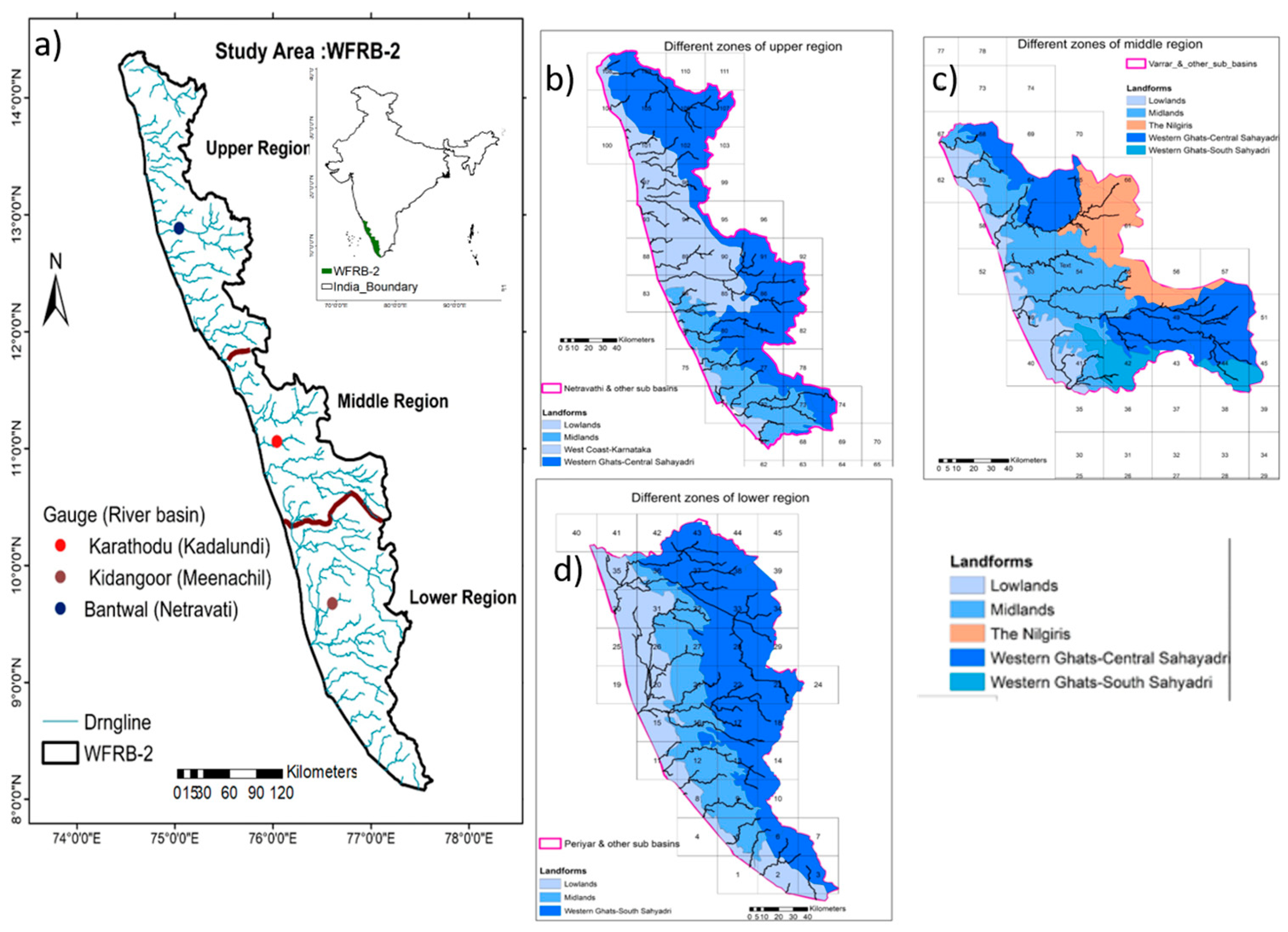
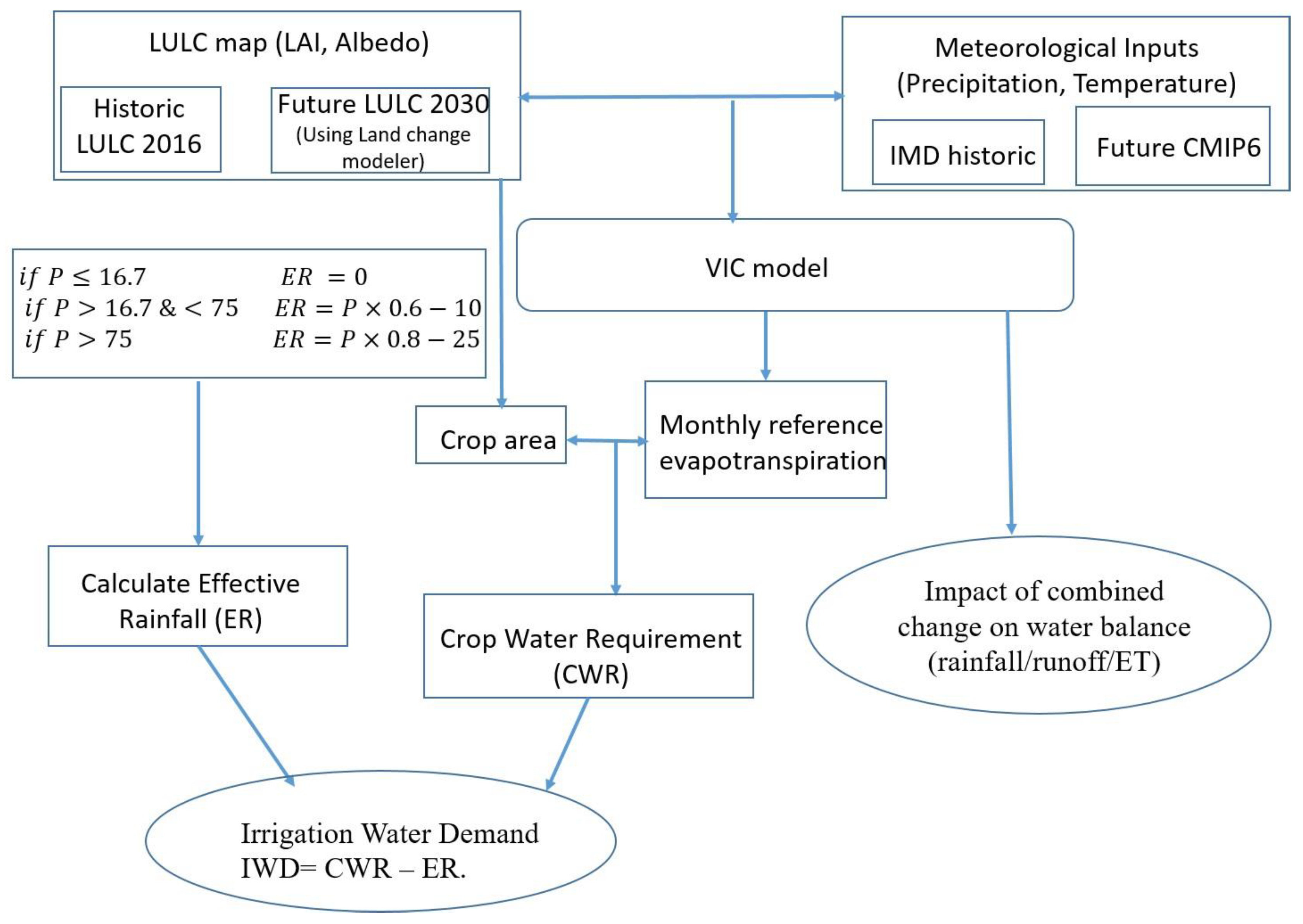

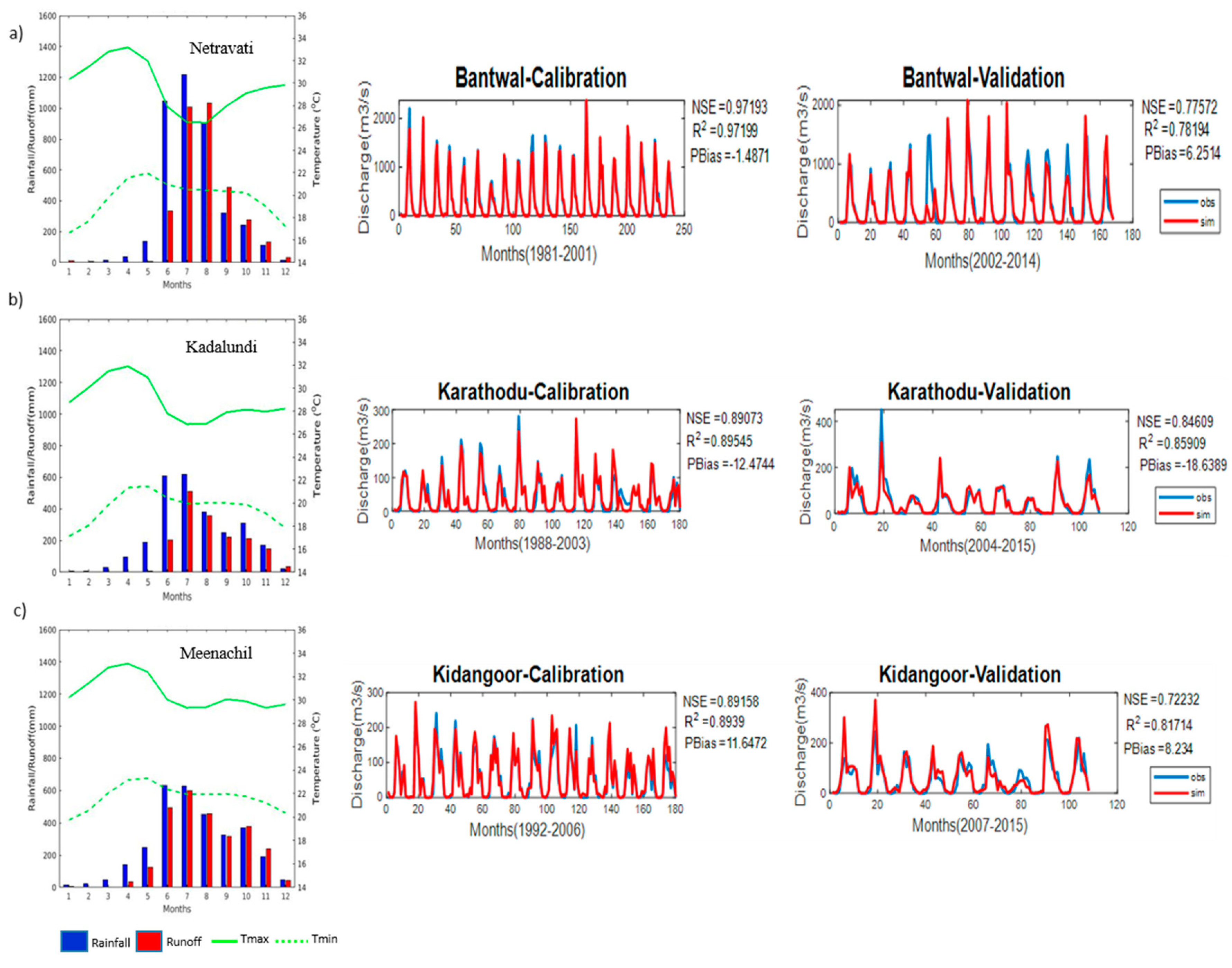
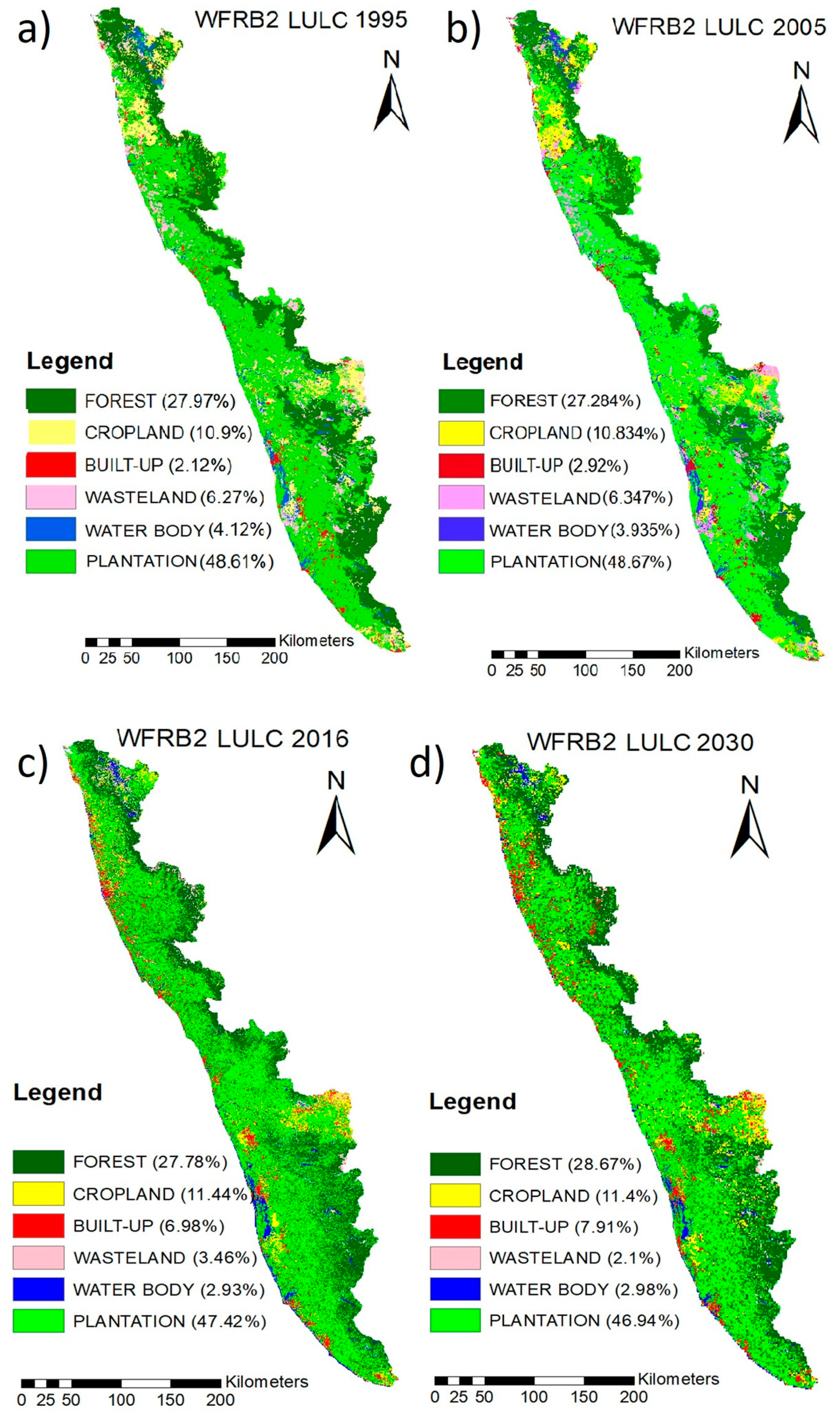
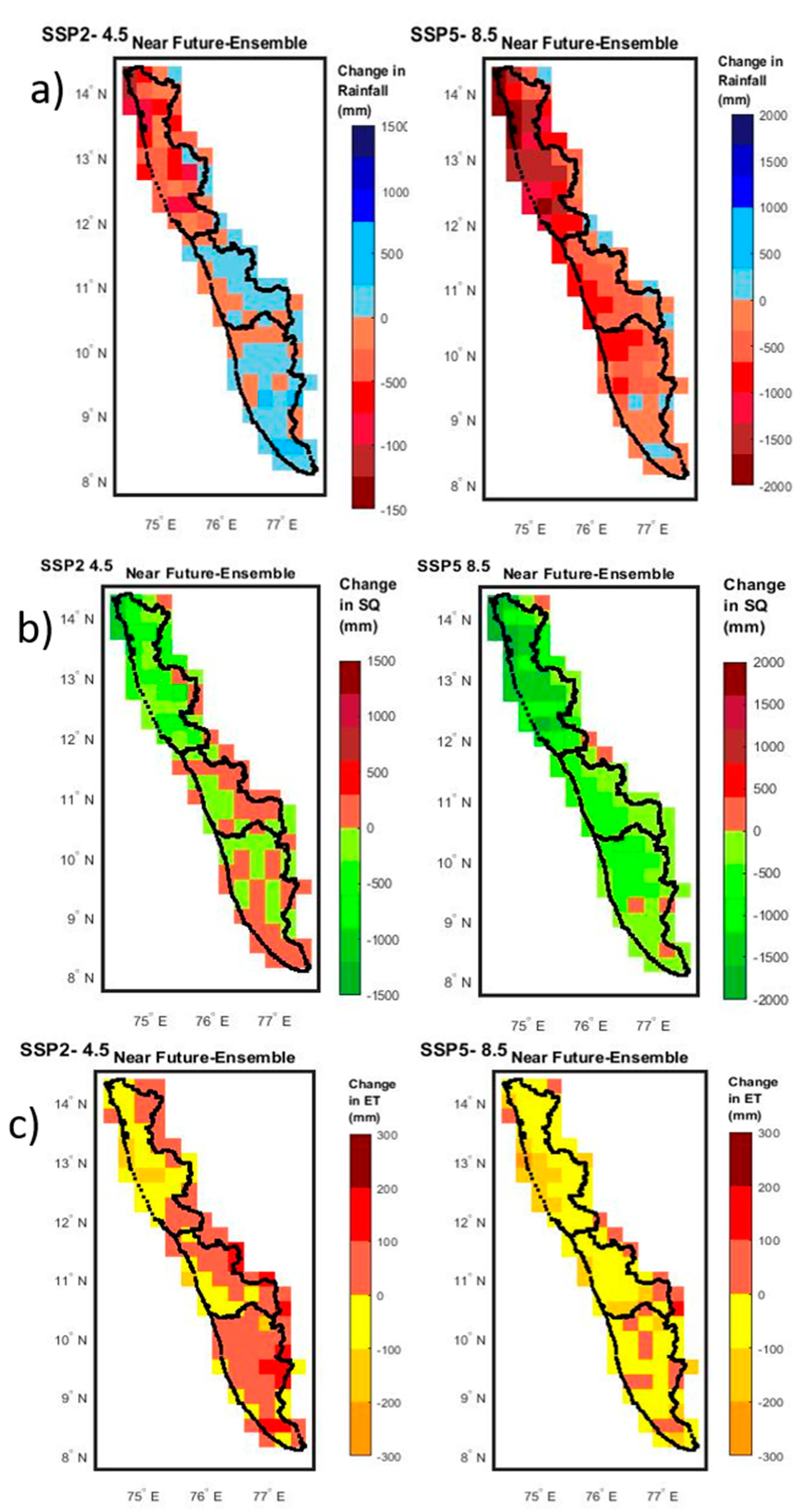
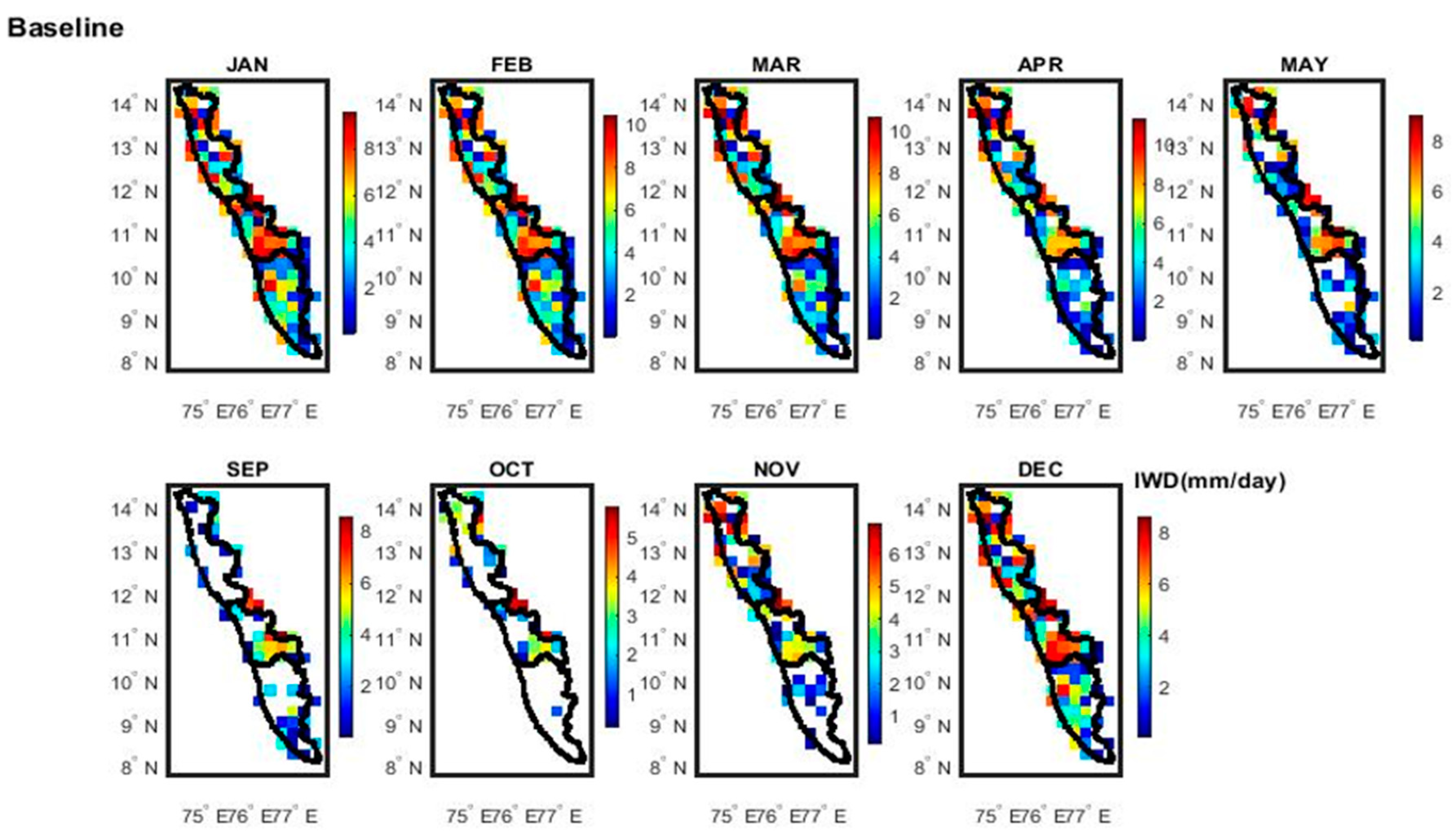
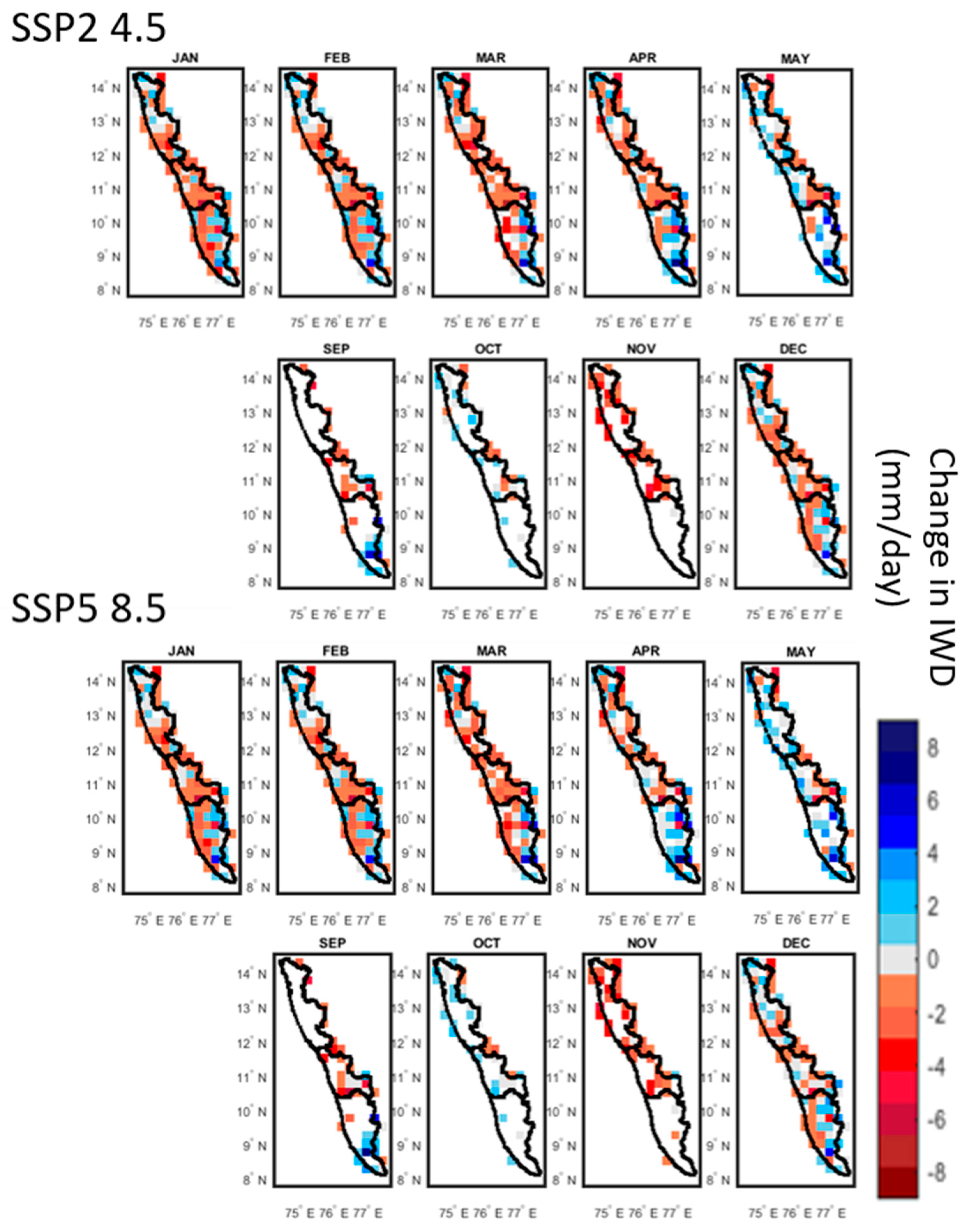
| Data Type | Time Period | Resolution Post-Processing | Source |
|---|---|---|---|
| Meteorological data | |||
| Historical | |||
| Precipitation | 1981–2011 | 0.25° × 0.25° | India Meteorological Department (IMD) |
| Temperature | 1981–2011 | 1.0° × 1.0° | |
| Future | GCM (CanESM5, CNRM-CM6-1, and MPI-ESM1-2-LR) | ||
| Precipitation | 2020–2050 | 0.25° × 0.25° | |
| Temperature | 2020–2050 | 0.5° × 0.5° | |
| Digital elevation model | 2005 | 30 m × 30 m | CartoDEM (bhuvan.nrsc.gov.in) National Bureau of Soil Survey and Land Use Planning (NBSS & LUP) |
| Soil map | 2012 | 30 arc second | |
| Historical LULC Future LULC | 2016 2030 | 30 m × 30 m 30 m × 30 m | Landsat (earthexplorer.usgs.gov) LULC projection |
| Gauge discharge | 1979–2015 | Daily | Central Water Commission (CWC) |
| LULC | 1995 | 2005 | 2016 | 2016 Predicted | 2030 |
|---|---|---|---|---|---|
| Forest | 27.97 | 27.284 | 27.04 | 27.85 | 28.74 |
| Cropland | 10.9 | 10.834 | 11.29 | 11.4 | 11.4 |
| Built-up | 2.12 | 2.92 | 6.64 | 6.98 | 7.91 |
| Wasteland | 6.27 | 6.347 | 3.57 | 3.46 | 2.1 |
| Water | 4.12 | 3.935 | 3.29 | 2.98 | 2.98 |
| Plantation | 48.61 | 48.67 | 48.14 | 47.35 | 46.87 |
| SSP 4.5 | SSP 8.5 | |||||
|---|---|---|---|---|---|---|
| Netravati and Other Sub-Basins | Lowlands | Midlands | Ghats | Lowlands | Midlands | Ghats |
| Baseline rainfall (mm/year) | 4026 | 3703 | 2546 | 4026 | 3703 | 2546 |
| Rainfall (% change) | −1.47 | −1.22 | −0.21 | −1.48 | −1.05 | −0.23 |
| TR (% change) | −0.03 | −2.28 | −0.15 | −0.24 | −2.16 | −0.16 |
| Varrar and Other Sub-basins | Lowlands | Midlands | Ghats | Lowlands | Midlands | Ghats |
| Baseline rainfall (mm/year) | 2931 | 2548 | 1501 | 2931 | 2548 | 1501 |
| Rainfall (% change) | −0.04 | 2.5 | 3.77 | −1.67 | −3.2 | −5.29 |
| TR (% change) | −2.11 | 1.4 | 2.81 | −2.63 | −2.53 | −3.66 |
| Periyar and Other Sub-basins | Lowlands | Midlands | Ghats | Lowlands | Midlands | Ghats |
| Baseline rainfall (mm/year) | 2400 | 2583 | 1357 | 2400 | 2583 | 1357 |
| Rainfall (% change) | 0.9 | −1.92 | −0.28 | −0.39 | −2.6 | −0.31 |
| TR (% change) | 1.3 | −1.62 | −3.06 | −1.71 | −2.0 | −0.93 |
Disclaimer/Publisher’s Note: The statements, opinions and data contained in all publications are solely those of the individual author(s) and contributor(s) and not of MDPI and/or the editor(s). MDPI and/or the editor(s) disclaim responsibility for any injury to people or property resulting from any ideas, methods, instructions or products referred to in the content. |
© 2023 by the authors. Licensee MDPI, Basel, Switzerland. This article is an open access article distributed under the terms and conditions of the Creative Commons Attribution (CC BY) license (https://creativecommons.org/licenses/by/4.0/).
Share and Cite
Eldho, T.I.; Chandu, N.; Sadhwani, K. A Comprehensive Study of Assessing Sustainable Agricultural Water Management under Changing Climate Scenarios—A Regional Basis Study in the Western Ghats, India. Sustainability 2023, 15, 13459. https://doi.org/10.3390/su151813459
Eldho TI, Chandu N, Sadhwani K. A Comprehensive Study of Assessing Sustainable Agricultural Water Management under Changing Climate Scenarios—A Regional Basis Study in the Western Ghats, India. Sustainability. 2023; 15(18):13459. https://doi.org/10.3390/su151813459
Chicago/Turabian StyleEldho, T. I., Navya Chandu, and Kashish Sadhwani. 2023. "A Comprehensive Study of Assessing Sustainable Agricultural Water Management under Changing Climate Scenarios—A Regional Basis Study in the Western Ghats, India" Sustainability 15, no. 18: 13459. https://doi.org/10.3390/su151813459







